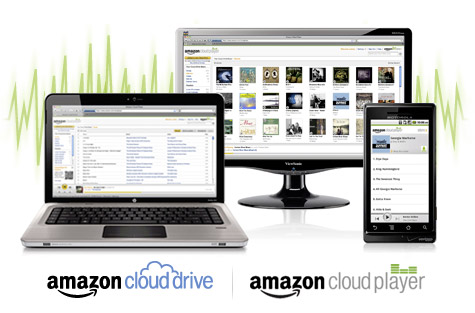
Music may have kicked off the digital media revolution with the rise of the MP3, but in recent years audio has taken a major backseat to video and communications. The more devices we pile up, the more fragmented our music collections become. Some don’t even bother downloading music at all anymore, instead opting for unlimited monthly services or radio alternatives like Pandora. Well, Amazon has taken a step toward changing that. Yesterday, the online retailer unveiled and released its Cloud Drive and Cloud Player, which let you upload music (or other files) to Amazon’s servers and stream them back on your computer or Android device. Apple and Google are both rumored to be launching some sort of streaming service as well.
In the last 24 hours, we’ve tested and played around with Amazon’s new service, which does many things well, but fails to deliver a few basic features that would turn its new Cloud Player from a good tool to a great way for music lovers to store and access their music.
Amazon’s Cloud Drive

How it works
Powering its new music storage service is the Cloud Drive, Amazon’s first consumer attempt at leveraging its massive farms of online storage. It has been selling storage and processing power to businesses for some time, but now you and I can take advantage. All Amazon users with an account get 5GB of storage for free. (This is already better than the 1GB of storage Google gives.) After that, storage costs about $1 per gigabyte per year. 20GB will cost you $20 a year; 50GB will cost you $50 a year; and so on; all the way to a full terabyte.
Files of all kinds can be uploaded and stored on the Cloud Drive, and can be downloaded from any device with an Internet connection and Cloud Drive app. Amazon gets the ball rolling with four default folders: Documents, Music, Pictures, and Video. You can use these folders or make your own; the folder creation process is simple and easy. A box-checking system can be used to copy or move files to new locations on your Cloud Drive.
The Good
It works well, uploads use an explorer window, and retrieving files is easy. Anyone who buys an Amazon MP3 automatically gets bumped up to 20GB of online storage. Better still, any new MP3s downloaded directly to the cloud drive on Amazon’s store will not use up your online storage at all. More on this in the next section.
The Bad
Users who want to get the most of Amazon’s Cloud Drive as a full backup may have trouble., as it isn’t intended for such a purpose. While files can be copied over with ease, I haven’t found a way to copy entire folders onto the Cloud Drive. Everyone has their own organization system, and it may be difficult for more hardcore users to fully utilize Amazon’s drive, even if they have purchased a full terabyte of data storage.
Amazon’s Cloud Player

Giant iPods used to be the norm, but as many users’ MP3 collections have grown, the capacity of phones and MP3 players has actually decreased. While a 64GB or 120GB MP3 player was normal a few years back, most modern smartphones and media players hold only 4GB to 16GB due to a shift to Flash storage, which is faster and better for batteries, but more expensive. In addition, music files now must sit next to games, apps, photos, and videos. There is no such thing as a music player anymore. Almost everything is a “media player.” Music has lost its prominence as technology has advanced.
Amazon could have released its Cloud Drive as a standalone product, but it went the extra mile and tried to solve one of today’s big problem: accessing and managing music collections. Most music is still purchased as standalone files, but modern users are on more and more devices. Until now, you’ve only been allowed to download a new MP3 once on services like Amazon MP3 and iTunes. So which device should you download it to? Your computer? Your smartphone? Your tablet? And once it’s there, how do you get the music to the rest of the devices? It’s a problem that has turned into a hassle for many users. The Cloud Player attempts to solve this problem, but falls short on the details.
How it works
Using an Adobe Air application, you can upload music files directly to your Cloud Drive. Amazon automatically sorts music by artist, album, genre, and songs. You can also create playlists, and view recent uploads and purchases with relative ease. Playing a file or album is as easy as clicking the play button next to it. Shuffle, pause, and repeat features are also included. The interface is very webby, but it works.
Buying music from Amazon’s MP3 store works differently. Instead of downloading it to your computer, you can now download it straight to your Cloud Drive, which intelligently adds it right into your collection.

The Good
I like the album view, and how simple it is to instantly access new music from anywhere. An already-released update to Amazon’s Android MP3 app has a built in Cloud Player. I downloaded a couple free songs on the MP3 store from my PC and instantly began streaming them and downloading them to my Motorola Droid. This, I like. Streaming appears to work very smoothly on Android devices and PCs with no degradation in quality. After a few moments, I forgot I was streaming music at all.
The Bad
Though it has all of the basic functions you need, Amazon’s Cloud Player will be too limited for some users and nearly unusable for others. Though you can create playlists, you cannot upload playlists you’ve already created. There is also no way to rate songs with stars, or thumb them up and down. However, the real problem is that there is no way to edit metadata (artist names, album names, song names, etc.) once music is in Amazon’s Cloud Player. The first upload I made was for a band called “The Damnwells.” However, one of the songs was listed as a separate artist “Damnwells.” There is no way to fix this unless I delete the file, fix it on my computer, and re-upload.
Though the service is Web-based, those using iOS devices or mobile Safari won’t have much luck. Amazon’s Cloud Player does not operate on these devices. Supposedly, it does work on Macs, though I was unable to test its performance.
Those who already use Amazon’s MP3 store may walk away feeling cheated as well. The Cloud Player does not automatically pull in any of the songs or albums you’ve downloaded from Amazon (though the company keeps such records). If you’d like to store previous Amazon MP3 purchases, you’ll have to upload them to the Cloud Player like anything else. And though you may already be a loyal Amazon MP3 user, don’t expect that 20GB storage bump unless you buy a new album. For a company that usually rewards its loyal users, Amazon is acting a bit out of character (see legal woes below).
The Ugly
Uploading music using Amazon’s Cloud Player is a pain if you happen to have a lot of MP3 files (especially in one folder). Instead of using a Windows Explorer window to choose files, Amazon forces you to download an Adobe Air app to find files. It was incapable of rendering my music list without crashing. In fact, it crashed nearly 10 times before I was able to upload a single album to the service. Uploading from an Android device is not yet offered.

I got very excited when I discovered that the uploader on Amazon’s Cloud Drive site used an explorer window instead of a crazy Adobe app. The Cloud Drive uploaded an album much easier and faster than the Cloud Player, but did not pull in the artist, album, or any relevant metadata. So now I’m stuck with several “Unknown Albums” by “Unknown Artist.” This is a severe enough flaw, but the lack of any way to change the metadata means that I can either delete these files or have a library full of mystery music.
I will admit that my music collection is large, but I don’t think I’m the only person with thousands of songs. Amazon needs to fix these problems if it hopes to make the Cloud Player and Drive usable for its target audience: music lovers.
Legal problems ahead

“We do not need a license to store music in Cloud Drive,” Amazon spokesperson Cat Griffin told Ars Technica “The functionality of saving MP3s to Cloud Drive is the same as if a customer were to save their music to an external hard drive or even iTunes.”
Not so, argues Sony, which launched its own “Music Unlimited” streaming service and is hoping for more money for the ability to store MP3s for users. Or perhaps Sony wishes to block the idea all together. Either way, Amazon appears to have consumers in mind, not record companies. Previously, Amazon has bent to industry pressure. Until now, users who purchased a $10 MP3 album were only allowed to download it once to one device. If the download failed, too bad. In a world where even Nintendo is letting users download purchased games more than once, the music industry’s stance seems dated. The more engaged people are with music and the easier it is to obtain it, listen to it, and share it, the more they will download.
Amazon’s own terms of service may hurt it as well. Though it promises security, PC Mag reports that its terms of service say otherwise. “We do not guarantee that Your Files will not be subject to misappropriation, loss or damage and we will not be liable if they are. You’re responsible for maintaining appropriate security, protection and backup of Your Files.”
Secure services like Carbonite are still a much better option for cloud-backup, it seems. If the law comes a knockin’, Amazon will show them your files, sensitive or not.
Amazon, you’re halfway there
I’ve been searching for a good cloud music solution for the last year or so, and the Cloud Player is the best service yet. Once the bugs are worked out and it’s easier to actually upload and manage a full music catalog in Amazon’s Cloud Player, I’m onboard. Unless, of course, Google or Apple come up with something much better. It’s good to see music get some attention again.
Editors' Recommendations
- Best MP3 players: a great music streamer for everyone
- Amazon Music now has a car mode, but don’t use it while driving


